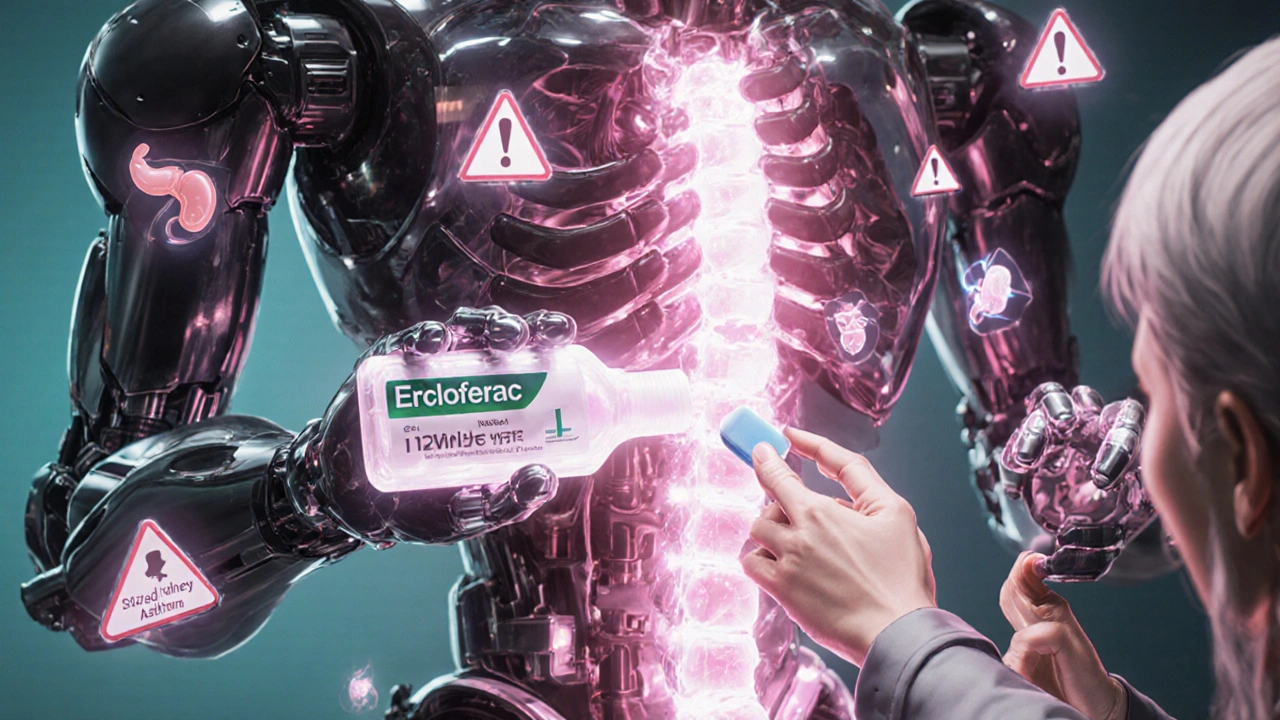 Oct, 29 2025
Oct, 29 2025
When you’ve got a sore knee, a stiff neck, or a strained muscle, you want relief fast. Emulgel with diclofenac is one of the most common topical painkillers prescribed in the UK. But is it the best option? And if it’s not working-or if you can’t use it-what else actually works? This isn’t about marketing. It’s about real people, real pain, and what’s been proven to help.
What is Emulgel (Diclofenac)?
Emulgel is a brand name for a topical gel containing diclofenac sodium, a non-steroidal anti-inflammatory drug (NSAID). It’s applied directly to the skin over painful joints or muscles. Unlike pills, it delivers the medicine right where you need it, with less risk of stomach upset or other systemic side effects. The gel absorbs quickly, and most people feel some relief within 30 to 60 minutes. It’s commonly used for osteoarthritis, sprains, strains, and minor sports injuries.
Each gram of Emulgel contains 1.16% diclofenac diethylamine, which converts to diclofenac acid once absorbed. That’s about 10mg of active diclofenac per gram. The usual dose is 2 to 4 grams applied 3 to 4 times a day, not exceeding 16 grams total per day. That’s roughly a 2-inch strip of gel per application.
Why People Look for Alternatives
Not everyone can use Emulgel. Some get skin rashes. Others have asthma triggered by NSAIDs. A few find it doesn’t help enough. And then there’s cost-Emulgel isn’t always covered by the NHS, and private prescriptions can add up.
People also want alternatives because they’re looking for something gentler, faster-acting, or more natural. Maybe they’ve tried Emulgel for two weeks and saw no change. Or they’re worried about long-term NSAID use, even topically. That’s fair. There are other options-and some work better for certain types of pain.
Topical NSAID Alternatives
Emulgel isn’t the only diclofenac gel on the market. But even beyond diclofenac, other topical NSAIDs exist.
- Ibuprofen gel (e.g., Nurofen Gel): Contains 5% ibuprofen. Less potent than diclofenac, but gentler on sensitive skin. Works well for mild to moderate pain. Studies show it’s about 70% as effective as diclofenac for osteoarthritis.
- Ketoprofen gel (e.g., Oruvail Gel): Stronger than ibuprofen, closer to diclofenac in power. Often used in Europe and the UK for chronic joint pain. May cause photosensitivity-don’t expose treated skin to strong sunlight.
- Piroxicam gel: Less common, but available. Used for deeper joint pain. Not as widely studied as diclofenac.
Here’s how they stack up:
| Product | Active Ingredient | Strength | Onset of Action | Best For | Key Limitation |
|---|---|---|---|---|---|
| Emulgel | Diclofenac diethylamine | 1.16% | 30-60 mins | Moderate to severe joint/muscle pain | Can cause skin irritation |
| Nurofen Gel | Ibuprofen | 5% | 45-90 mins | Mild pain, sensitive skin | Less effective for deep inflammation |
| Ketoprofen Gel | Ketoprofen | 2.5% | 20-40 mins | Chronic arthritis, deep tissue | Photosensitivity risk |
| Voltaren Emulgel | Diclofenac sodium | 1% | 30-60 mins | Same as Emulgel | Similar side effects, higher cost |
Notice that Voltaren Emulgel is essentially the same as Emulgel-same active ingredient, same strength, just a different brand. In the UK, Emulgel is often cheaper and more widely available through pharmacies.

Non-NSAID Topical Options
If NSAIDs aren’t working-or you want to avoid them entirely-there are other gels and creams.
- Capsaicin cream: Made from chili peppers. Works by depleting substance P, a chemical that sends pain signals. Takes 2-4 weeks to show full effect. Burns at first use-some people can’t tolerate it. Great for nerve-related pain like post-herpetic neuralgia.
- Menthol or camphor creams (e.g., Deep Heat, Tiger Balm): These are counterirritants. They create a cooling or warming sensation that distracts from pain. No real anti-inflammatory effect, but useful for temporary relief during movement or before activity.
- Arnica gel: Herbal remedy. Some small studies suggest mild benefit for bruising and swelling. Not strong enough for arthritis pain, but safe and gentle. Good for minor bumps or post-workout soreness.
One thing to know: counterirritants like menthol don’t heal anything. They just make the pain feel less noticeable. If you’re relying on them long-term, you might be masking a problem that needs real treatment.
Oral Alternatives to Consider
Topical gels aren’t always enough. If your pain is widespread or severe, you might need something stronger.
- Paracetamol: Safe for most people. Doesn’t reduce inflammation, but helps with mild pain. Often paired with topical gels.
- Oral NSAIDs (e.g., naproxen, celecoxib): More effective for systemic inflammation, but carry higher risks-stomach ulcers, kidney strain, heart issues. Only use short-term and under medical supervision.
- Codeine or tramadol: Weak opioids. Reserved for severe pain when other options fail. Risk of dependence. Not recommended for long-term use.
Here’s the reality: if topical diclofenac isn’t working, adding oral paracetamol often helps more than switching to another gel. A 2023 review in the British Journal of General Practice found that combining topical NSAIDs with oral paracetamol improved pain scores by 40% more than either alone in patients with knee osteoarthritis.
When to Skip Gels Altogether
Some conditions don’t respond to topical treatments.
- Spinal pain (e.g., sciatica)
- Deep joint inflammation (e.g., rheumatoid arthritis)
- Pain caused by nerve damage
- Swelling that’s internal, not surface-level
If you’ve tried Emulgel for 2 weeks with no improvement, or if your pain is getting worse, it’s time to see a GP or physiotherapist. You might need imaging, injections, or a tailored exercise plan.

Real-Life Use Tips
Even the best gel won’t work if you use it wrong.
- Apply only to clean, dry, unbroken skin.
- Wash your hands after applying-unless you’re treating your hands.
- Don’t cover the area with a bandage unless told to.
- Avoid sunlight on treated skin for 12 hours after application (especially with ketoprofen or diclofenac).
- Wait at least 30 minutes before showering or swimming.
- Don’t use more than 4 times a day. More isn’t better.
Also, give it time. Topical NSAIDs don’t work like a painkiller pill. They build up over days. Most people see real improvement after 3-7 days of consistent use.
What’s the Best Choice?
There’s no single winner. It depends on your pain, your skin, and your health.
- Choose Emulgel if you have moderate joint or muscle pain and your skin tolerates NSAIDs.
- Choose ibuprofen gel if you have sensitive skin or mild pain and want something gentler.
- Choose ketoprofen if you’ve tried diclofenac and need something stronger-but avoid sun exposure.
- Try capsaicin if your pain feels like burning or tingling (nerve pain).
- Use menthol creams for quick, temporary relief before activity.
- Combine with paracetamol if topical alone isn’t enough.
And remember: gels are tools, not cures. They help manage pain, but they don’t fix the root cause. Movement, strength training, and weight management often matter more in the long run.
Can I use Emulgel with other painkillers?
Yes, you can safely use Emulgel with paracetamol. Many people combine them for better relief. Avoid combining it with oral NSAIDs like ibuprofen or naproxen unless your doctor says it’s okay. Using multiple NSAIDs increases your risk of side effects without adding much benefit.
How long can I use diclofenac gel for?
For acute injuries like sprains, use it for up to 2 weeks. For chronic conditions like osteoarthritis, you can use it for longer-but only if it’s helping and you’re not getting skin irritation. Most GPs recommend taking a break every 3 months to check if you still need it. Long-term use without review isn’t advised.
Is Emulgel better than tablets?
For localized pain, yes. Topical diclofenac delivers the drug right to the sore spot with about 10% of the systemic exposure compared to tablets. That means fewer stomach issues, lower risk of kidney strain, and less chance of interacting with other medications. But if your pain is all over-like widespread arthritis-tablets might be more effective.
Can I use Emulgel if I have asthma?
Some people with asthma are sensitive to NSAIDs, even topical ones. If you’ve ever had a flare-up after taking ibuprofen or aspirin, talk to your doctor before using Emulgel. It’s not guaranteed to cause problems, but the risk exists. Safer alternatives include paracetamol or capsaicin cream.
What if Emulgel irritates my skin?
Stop using it. Skin reactions like redness, itching, or peeling are common. Try switching to an ibuprofen gel or capsaicin cream, which are less likely to irritate. If irritation persists, see your GP. You might need a different treatment path, like a corticosteroid injection or physiotherapy.
Final Thoughts
Emulgel is a solid choice for many people with joint or muscle pain. But it’s not the only option-and it’s not always the best. The key is matching the treatment to your pain type, your body’s response, and your lifestyle. Don’t stick with something that doesn’t work just because it’s familiar. Try alternatives. Track what helps. And don’t ignore the bigger picture: movement, rest, and professional advice matter just as much as the gel you rub on.
Holly Dorger
October 30, 2025 AT 05:50I tried Emulgel for my knee and it did absolutely nothing. My skin just got red and itchy. Switched to ibuprofen gel and it was way gentler. Not as strong but at least I didn’t feel like I’d been slapped with a hot pepper.
Amanda Nicolson
October 30, 2025 AT 07:51Oh my god I feel you. I’ve been dealing with chronic hip pain for years and I’ve tried every gel under the sun. Emulgel? Felt like my skin was on fire. Ketoprofen? I had to stop because I got sunburned just walking to my mailbox. Then I tried capsaicin and honestly? It felt like my leg was being stabbed by tiny fiery needles for two weeks… but then? Magic. Like, actual magic. Now I use it every night and I can finally sleep without waking up screaming. It’s not pretty but it works. Also, paracetamol on the side? Game changer. Don’t be afraid to mix and match. Pain is weird and personal.
Jackson Olsen
October 30, 2025 AT 10:40capsaicin burns but it works for nerve pain
emulgel good for joints
ibuprofen gel for sensitive skin
menthol just distracts
paracetamol helps if you combine
Prakash pawar
October 30, 2025 AT 22:03Let me tell you something my fellow suffering mortals. The pharmaceutical industry doesn’t want you to know that real healing comes from movement, not chemicals. You rub gel on your knee and think you’re fixing it? No. You’re just numbing the symptom like a child who cries and gets candy. The body doesn’t need more NSAIDs. It needs yoga. It needs cold showers. It needs to stop sitting on its ass all day. I’ve cured my arthritis by walking barefoot on grass for 20 minutes every morning. No gel. No pills. Just nature and willpower. Emulgel? That’s just corporate snake oil dressed in a blue tube.
MOLLY SURNO
October 31, 2025 AT 15:28Thank you for this comprehensive and well-researched overview. I appreciate the clear comparison between topical agents and the emphasis on combining treatments appropriately. Many patients are unaware that combining topical NSAIDs with paracetamol can yield significantly better results than either alone. This kind of evidence-based clarity is invaluable in managing chronic musculoskeletal pain.
Alex Hundert
November 1, 2025 AT 11:47Prakash, your ‘barefoot on grass’ nonsense is why people don’t trust real medicine. If you think walking on grass fixes osteoarthritis, you’ve never had a knee that grinds like gravel. Emulgel isn’t a crutch-it’s a tool. And if you’re too stubborn to use it because you think pain is a ‘spiritual lesson,’ then go ahead and limp through life. But don’t tell others to suffer instead of trying something that works. I’ve been on 3 different gels, two physio programs, and a cortisone shot. The only thing that got me back to hiking? Diclofenac. Simple. Science. No magic dirt required.
Emily Kidd
November 2, 2025 AT 09:00PSA: if your skin gets irritated by Emulgel, try the generic diclofenac gel from Walmart. Same stuff, half the price, and way less fragrance. Also, if you’re using it for arthritis, give it at least 5 days. I thought it wasn’t working until day 6 and then boom-could finally open jars again. And yes, paracetamol + gel = best combo. My mom uses it and she’s 72 and still gardening. No drama. No burns. Just results.
Justin Cheah
November 4, 2025 AT 07:57Have you ever stopped to ask who profits from these gels? Big Pharma knows most people won’t stick with capsaicin because it burns. They push diclofenac because it’s patentable, profitable, and keeps you coming back. And what about the photosensitivity warning? That’s not an accident. It’s a liability shield. They want you to think it’s just ‘sun exposure’ but really, it’s a hidden systemic effect they don’t want you to connect to liver strain or autoimmune flares. And don’t get me started on the NHS coverage. They ration it so you’ll upgrade to branded versions. This whole system is designed to keep you medicated but never healed. You’re not broken. You’re being exploited.
caiden gilbert
November 5, 2025 AT 14:48I used to think gels were just fancy lotion until I tried ketoprofen after a bad bike fall. Felt like someone poured liquid ice directly into my tendon. Not magic, but like… targeted relief. Like your body finally got a VIP pass to chill out. I still use it for my shoulder after lifting. And yeah, the sun thing is real-I got a weird patch of redness once and learned the hard way. Now I wear long sleeves and laugh at people in tank tops with gel on their arms. You’re not a superhero. You’re a human with a prescription.
phenter mine
November 6, 2025 AT 10:48just wanted to say thanks for this i was about to give up on gels entirely but now i’m gonna try the ibuprofen one and pair it with tylenol. also i spelled paracetamol wrong in my head like 5 times lmao